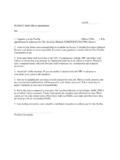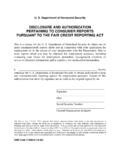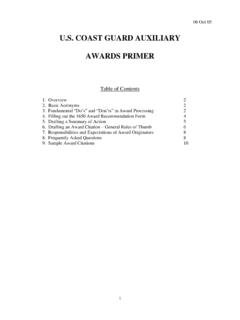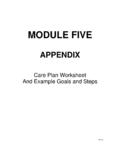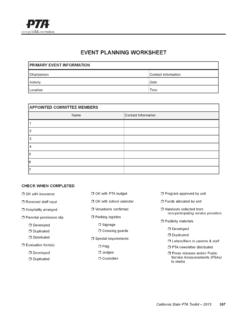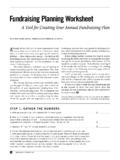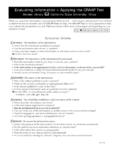Transcription of Risk Calculation Worksheet - Calculating Risk Using …
1 Risk Calculation Worksheet - Calculating Risk Using GAR Model ( green - amber - RED)The purpose of the GAR model is to help identify and evaluate the risk of a given operation. To compute the total level of risk for each hazard identified below, assign a risk code of 0 (For No Risk) through 10 (For Maximum Risk) to each of the six elements. This is your personal estimate of the risk. Add the risk scores to come up with a Total Risk Score for each hazard. SUPERVISION Supervisory Control considers the qualification and effectiveness of the supervision.
2 Even if a person is qualified to perform a task, supervision acts as a control to minimize risk. This may simply be someone checking what is being done to ensure it is being done correctly. The higher the risk, the more the supervisor needs to be focused on observing and checking. A supervisor who is actively involved in a task (doing something) is easily distracted and should not be considered an effective safety observer in moderate to high-risk conditions. PLANNING Planning and preparation should consider how much information you have, how clear it is, and how much time you have to plan the evolution or evaluate the situation.
3 TEAM SELECTION Team selection should consider the qualifications and experience level of the individuals used for the specific event/evolution. Individuals may need to be replaced during the vent/evolution and the experience level of the new team members should be assessed. TEAM FITNESS Team fitness should consider the physical and mental state of the crew. This is a function of the amount and quality of rest a crewmember has had. Quality of rest should consider how the ship rides, its habitability, potential sleep length, and any interruptions.
4 Fatigue normally becomes a factor after 18 hours without rest; however, lack of quality sleep builds a deficit that worsens the effects of fatigue. ENVIRONMENT Environment should consider factors affecting personnel performance as well as the performance of the asset or resource. This includes, but is not limited to, time of day, temperature, humidity, precipitation, wind and sea conditions, proximity of aerial/navigational hazards and other exposures ( , oxygen deficiency, toxic chemicals, and/or injury from falls and sharp objects).
5 EVENT or EVOLUTION COMPLEXITY Event/Evolution complexity should consider both the required time and the situation. Generally, the longer one is exposed to a hazard, the greater are the risks. However, each circumstance is unique. For example, more iterations of an evolution can increase the opportunity for a loss to occur, but may have the positive effect of improving the proficiency of the team, thus possibly decreasing the chance of error. This would depend upon the experience level of the team. The situation includes considering how long the environmental conditions will remain stable and the complexity of the work.
6 Assign a risk code of 0 (For No Risk) through 10 (For Maximum Risk) to each of the six elements below. Supervision Team Fitness Planning Environment Team Selection Event/Evolution Complexity Total Risk Score The mission risk can be visualized Using the colors of a traffic light. If the total risk value falls in the green ZONE (1-23), risk is rated as low. If the total risk value falls in the amber ZONE (24-44), risk is moderate and you should consider adopting procedures to minimize the risk. If the total value falls in the RED ZONE (45-60), you should implement measures to reduce the risk prior to starting the event or evolution.
7 GAR Evaluation Scale Color Coding the Level 0f Risk 0 23 44 60 The ability to assign numerical values or color codes to hazards Using the GAR Model is not the most important part of risk assessment. What is critical to this step is team discussions leading to an understanding of the risks and how they will be managed. Report the GAR score to the Sector Command Center at (phone number) or the (PATCOM/ COMMS GUY) before the operation.
8 10 20 30 40 50 green (Low Risk) amber RED (Caution) (High Risk)
